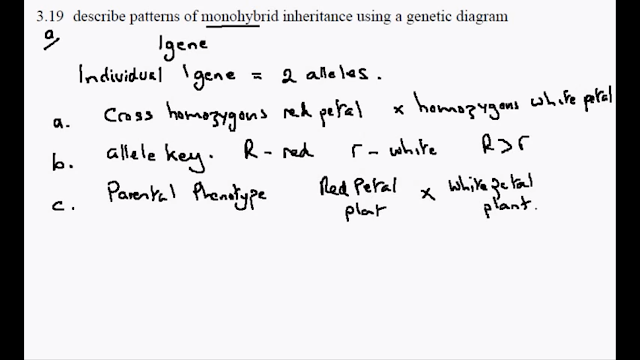3.2 Understand that fertilization involves the fusion of a male and female gamete to produce a zygote that undergoes cell division and develops into an embryo.
The process begins with the adult male (cell in testis) + Adult female (cell in ovary)
These cells have a complete set of chromosomes. This is called being diploid (2n)
For humans it's 46.
These cells divide in the testis to produce a half sets (Gametes). These are know as the sperm cells the the adult male.
This process of cell division is called meiosis.
We got from a diploid to a haploid number (n). This is a half set.
This would be 23 for humans.
In sexual reproduction these cells are brought together and they are joined or fused together, and from a single cell. This is known as fertilization. Combining two half sets of chromosomes to form a full set of chromosomes. eg. 23 + 23 = 46.
This cell is known as a zygote. This is a new cell which is a combination of the male and female chromosomes.
After this mitosis occurs in which the cells will divide.
Monday, September 26, 2011
Phenotypes
3.18 recall the meaning of the terms: Dominant, recessive, Homozygous, Heterozygous, phenotype, genotype and codominance.
Monday, September 19, 2011
Male reproductive system
3.9 a recall the structure and function of the male reproductive system.
Bladder - To store Urine
testis - carry out the process of meiosis that produces the gametes called the sperm cells.
Epididymis - Store sperm cells.
Vas Deferens - pushes the sperm cells to penis
prostate - adds about 20/30% of semen sugars and is also alkali.
Seminal Vesicles - 70% of semen " "
Urethra - Common tube which joins the left and right testis and vas defrence. It is also the exit of urine.
Penis - Carry sperm cells into the vagina.
Bladder - To store Urine
testis - carry out the process of meiosis that produces the gametes called the sperm cells.
Epididymis - Store sperm cells.
Vas Deferens - pushes the sperm cells to penis
prostate - adds about 20/30% of semen sugars and is also alkali.
Seminal Vesicles - 70% of semen " "
Urethra - Common tube which joins the left and right testis and vas defrence. It is also the exit of urine.
Penis - Carry sperm cells into the vagina.
Monday, September 12, 2011
Amniotic Fluid
3.12 Understand how the developing embryo is protected by amniotic fluid fluid.
Amniotic fluid: The fluid surrounding a fetus within the amnion.
Amnion: The innermost membrane that encloses the embryo of a mammal, bird, or reptile.
One of the functions of the amniotic fluid is that it can protect the developing embryo. The fluid which is largely water cannot be compressed. When we try to squeeze it, ti absorbs the pressure.
Amniotic fluid: The fluid surrounding a fetus within the amnion.
Amnion: The innermost membrane that encloses the embryo of a mammal, bird, or reptile.
One of the functions of the amniotic fluid is that it can protect the developing embryo. The fluid which is largely water cannot be compressed. When we try to squeeze it, ti absorbs the pressure.
The Placenta
3.11 describe the role of the placenta in the nutrition of the developing embryo.


First of all,. a placenta is a flattened circular organ in the uterus of pregnant eutherian mammals, nourishing and maintaining the fetus through the umbilical cord.
When a child is still in the uterus, it is a water filled environment (amniotic fluids). At that time a child cannot digest or breath and is unable to carry out excretion.
How does the child net nutrition?
It has the placental structure growing out of the developing embryo. It does not grow out of the mother.
Also, the blood vessels inside the placenta are the CHILD's blood vessels.
Things like glucose, fats and amino acids would travel through the mothers blood stream and into the wall of the uterus. These nutrients will then cross into the child's blood at the placenta.
The placenta has a large surface area and the barrier is very thin.
The child also produces molecules that are sent back into the maternal blood (e.g. CO2 and urea).


First of all,. a placenta is a flattened circular organ in the uterus of pregnant eutherian mammals, nourishing and maintaining the fetus through the umbilical cord.
When a child is still in the uterus, it is a water filled environment (amniotic fluids). At that time a child cannot digest or breath and is unable to carry out excretion.
How does the child net nutrition?
It has the placental structure growing out of the developing embryo. It does not grow out of the mother.
Also, the blood vessels inside the placenta are the CHILD's blood vessels.
Things like glucose, fats and amino acids would travel through the mothers blood stream and into the wall of the uterus. These nutrients will then cross into the child's blood at the placenta.
The placenta has a large surface area and the barrier is very thin.
The child also produces molecules that are sent back into the maternal blood (e.g. CO2 and urea).
Subscribe to:
Posts (Atom)











